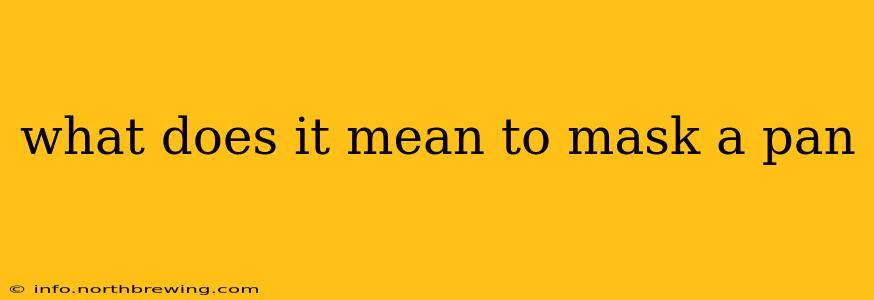What Does It Mean to Mask a Pan?
"Masking a pan" in cooking refers to the process of coating the pan's surface with a thin layer of oil or fat before adding other ingredients. This technique serves several crucial purposes, significantly impacting the final dish's quality and the ease of cooking. Let's explore the "why" and "how" of masking a pan.
Why Mask a Pan?
The primary reason for masking a pan is to prevent sticking. Many foods, especially eggs, delicate fish fillets, or anything prone to sticking, benefit from this technique. The thin layer of oil creates a barrier between the food and the pan's surface, allowing for easy flipping and removal without tearing or breaking.
Beyond preventing sticking, masking a pan also contributes to:
- Even Browning: The oil distributes heat more evenly across the pan's surface, leading to more uniform browning and cooking. This is particularly important when searing meat or sautéing vegetables.
- Enhanced Flavor Development: The oil helps to create a flavorful crust on food, especially when high heat is used. The Maillard reaction, responsible for that delicious browned crust, is facilitated by the presence of oil.
- Reduced Risk of Burning: The oil acts as a heat conductor and prevents direct contact between the food and the extremely hot pan surface, reducing the chances of burning, especially with delicate ingredients.
What Oils Are Best for Masking a Pan?
The best oil for masking a pan depends on the cooking temperature and the type of food. Generally, oils with a high smoke point are preferred for higher heat cooking methods like searing:
- Avocado Oil: High smoke point, neutral flavor.
- Grapeseed Oil: High smoke point, neutral flavor.
- Canola Oil: High smoke point, mild flavor.
- Vegetable Oil: High smoke point, neutral flavor.
For lower heat cooking, oils with more pronounced flavors can be used, such as olive oil (though its lower smoke point limits its use for high heat).
How Much Oil Should I Use?
The amount of oil needed for masking a pan is minimal. You shouldn't be swimming in oil – just enough to create a very thin, even coat across the entire surface. A teaspoon or less is often sufficient for a standard-sized pan. The best technique is to add the oil to the hot pan and then swirl it around to distribute evenly before adding the food.
What if I Forget to Mask the Pan?
If you forget to mask your pan, it's not necessarily a culinary disaster. However, the risk of sticking significantly increases. You may find it more challenging to remove your food from the pan without damaging it. Sometimes, using a spatula or non-stick cooking spray can help to mitigate the sticking, but preventative masking is always the preferred approach.
Is Masking a Pan the Same as Seasoning a Pan?
No, masking a pan and seasoning a pan are distinct processes. Seasoning a pan involves creating a non-stick layer on the pan's surface over time by applying oil and heating it repeatedly. This is typically done with cast iron pans and creates a long-term protective layer. Masking a pan is a temporary technique performed before each cooking session to prevent sticking for a single cooking event.
By understanding the purpose and techniques of masking a pan, you can elevate your cooking skills and create consistently better results in the kitchen. Remember, a little oil goes a long way in preventing sticking and enhancing the overall quality of your dishes.
